Landscape composition: Servants to Composition

Up to now in my series of articles on composition in landscape photography, I have discussed compositional elements, their weight, and how to use their properties to balance the composition by imagining a balance of forces around the central axis of an image. I have also tackled the balancing of negative space, the perception of subject direction, and the often overlooked importance I attribute to the separation of elements. Subsequently, I delved into the perception of depth and how to utilize the sky in a landscape image, and finally, how to connect the elements in a way that makes sense. Finally, I suggested an idea to guide the photographer during in-field composition.
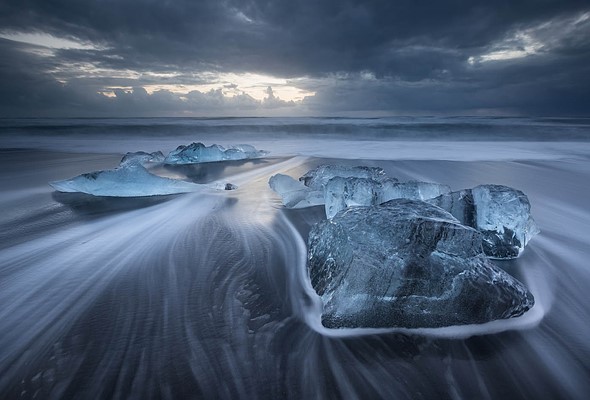 This image of beached icebergs on Breiðamerkursandur beach in southern Iceland is an excellent example of well-known compositional principles and ideas. Can you identify them? How has the photographer improved the composition and the overall image using these principles, and how do we relate them to the ideas discussed in this series?
This image of beached icebergs on Breiðamerkursandur beach in southern Iceland is an excellent example of well-known compositional principles and ideas. Can you identify them? How has the photographer improved the composition and the overall image using these principles, and how do we relate them to the ideas discussed in this series?
Canon 5D3, Canon 16-35 F2.8L II, 16mm, F16, 4 seconds, ISO 100
Long Exposures
Long exposures are often associated with "magical" images, such as silky waterfalls or reflective mirror-like bodies of water. However, more than just a way to impart a sense of magic to an image, long exposures are a tool of composition.
To support this assertion, let's harken back to what was discussed earlier in the series, particularly the concept of negative space and element separation. I argued that the compositional masses in an image should be surrounded by negative space and adequately separated from each other and the frame's edges. This contributes to a better perception of depth in a two-dimensional image.
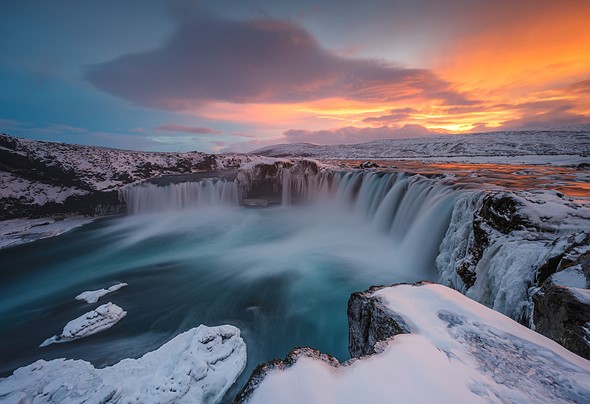 How do long exposures contribute to this image? Try to answer both from a compositional standpoint and other aspects of the image.
How do long exposures contribute to this image? Try to answer both from a compositional standpoint and other aspects of the image.
Canon 5D4, Canon 11-24mm F4, 13mm, F14, 13 seconds, ISO 100
Goðafoss Waterfall, Northern Iceland
When photographing a landscape with moving elements, like clouds or water, these elements can create unwanted visual distractions. Rippling waves can draw attention away from beautiful rugged rocks in a seascape, for example. Chaos also makes it harder to distinguish and separate elements, which deeply affects the sense of depth in the image. Long exposures help mitigate this effect, aiding in the separation of compositional elements and reducing visual noise.
 Long exposures have aided in separating the various rocky masses in this composition and exposing more detail in the foreground element.
Long exposures have aided in separating the various rocky masses in this composition and exposing more detail in the foreground element.
Canon 5D3, Canon 16-35mm F2.8L II, 16mm, F13, 20 seconds, ISO 400
Anse Source d'Argent, La Digue Island, Seychelles
Long exposures often "smooth out" moving elements, creating a more uniform surface. This reduces visual noise between the main elements and enhances the perception of depth.
What long exposures typically do to chaotic elements is mediate them. Waves are high in one part of space and low in another, but a second later, the situation reverses. Exposing while both of these moments occur makes the water appear flatter with fewer details, and the composition has less visual noise among the main elements, the elements we want the viewer to focus on. A long exposure serves to create adequate negative space around the subjects and separation between them, thus contributing to depth.
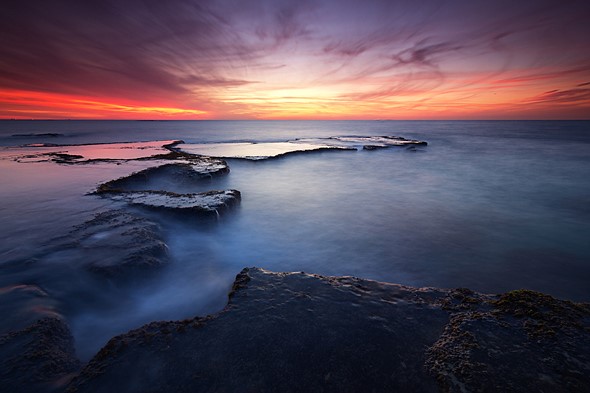 These beautiful rock formations wouldn't be as prominent without the long exposure.
These beautiful rock formations wouldn't be as prominent without the long exposure.
Canon 60D, Canon EF-S 10-22mm F3.5-4.5, 10mm, F11, 30 seconds, ISO 100
Palmachim Beach, Israel
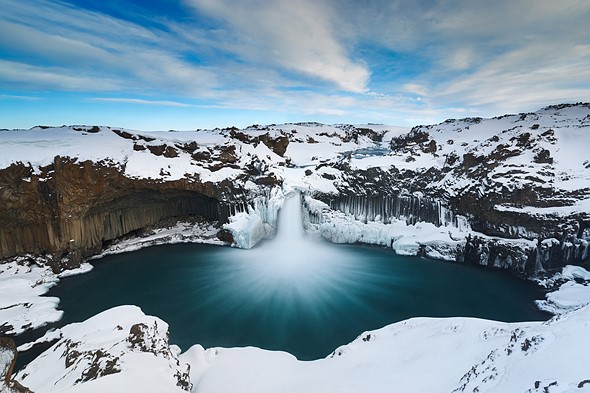 The long exposure has created streaks extending away from the waterfall. How does this complement the composition, in line with what was discussed earlier?
The long exposure has created streaks extending away from the waterfall. How does this complement the composition, in line with what was discussed earlier?
Canon 5D3, Canon 16-35mm F2.8 II, 18mm, F16, ISO 50, multiple exposures of 5 and 15 seconds
Aldejyarfoss, Iceland
The Rule of Thirds
The rule of thirds is widely known and often used by photographers but can also be a subject of criticism by experts. However, it's important to understand that it's not a rigid rule to be followed at all times but rather a flexible guideline.
The rule of thirds is based on the progressive positioning of subjects relative to the central axis of the image. This contributes to a sense of depth and separation of compositional elements.
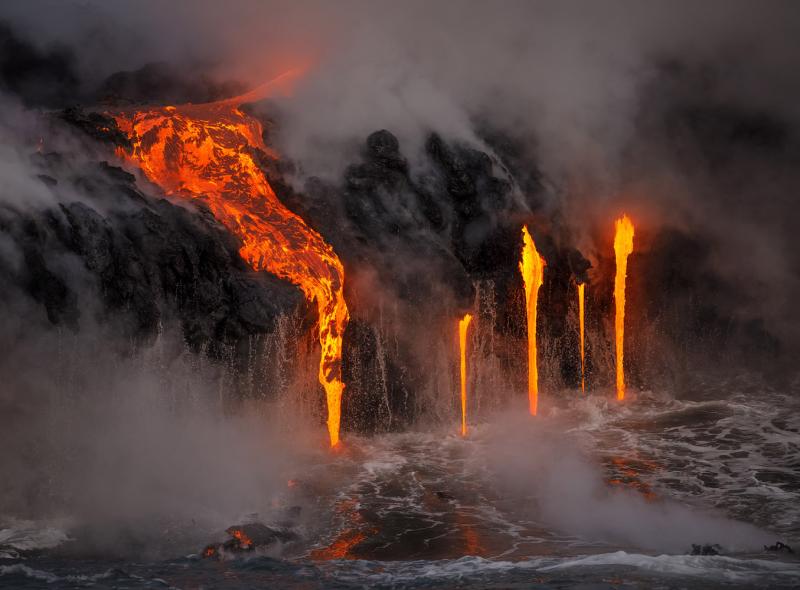
One aspect to consider regarding the rule of thirds is that, while it is a useful guideline, it cannot be rigidly applied to every photographic scenario and composition. The size, direction, and position of a main subject can vary significantly and must be considered and adjusted based on the context. Nevertheless, the fundamental concept of the rule of thirds, which requires placing subjects progressively towards the sides opposite the central axis of the image, has a solid foundation in composition.
This arrangement of subjects aligns with the principles of compositional weight and subject direction, helping guide the viewer's eye across the image from side to side, thereby adding depth to the composition. Additionally, this thirds-based positioning has the advantage of maintaining a proper distance between subjects and the frame's edges, emphasizing the separation between elements. In short, it's a flexible yet effective guide for creating engaging compositions that can be summarized in a few words.
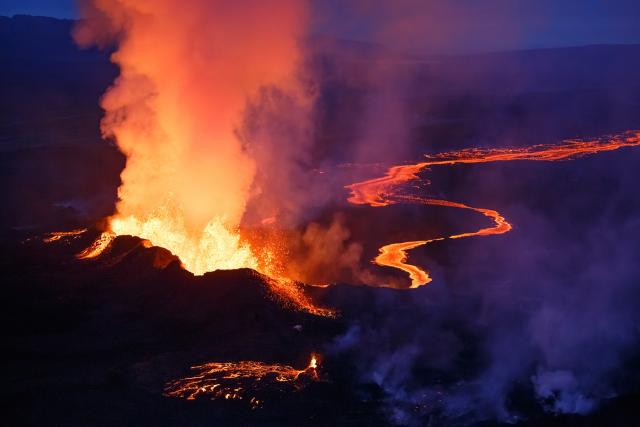 The main subject of this image, the erupting fissure, is positioned approximately on a third. The line emerging from it (the lava stream) contributes to the perception of its orientation to the right, so the photographer had to provide more negative space in that direction. If placed more to the right, there would have been too much dead space on the left, while positioning it more to the left would compromise separation from the frame's edge.
The main subject of this image, the erupting fissure, is positioned approximately on a third. The line emerging from it (the lava stream) contributes to the perception of its orientation to the right, so the photographer had to provide more negative space in that direction. If placed more to the right, there would have been too much dead space on the left, while positioning it more to the left would compromise separation from the frame's edge.
Holuhraun Eruption, Iceland, 2014
Canon 5D3, Canon 70-300mm F4-5.6, 1/1250 sec, F4, ISO 3200
In the context of the discussion about balancing compositional weights, I explained that the position of a compositional element in an image is directly proportional to its compositional weight. In other words, if an element has greater weight, it should be placed closer to the central axis of the image to balance other elements with similar weight. The rule of thirds can be seen as a practical guide for determining the distance from the central axis that corresponds to a subject of medium compositional weight, which serves as a reference point for balancing other subjects.
This approach provides a basic logic behind the often-misunderstood rule of thirds and will be further clarified in the upcoming discussions in this series. It's important to recognize that the rule of thirds is a flexible guide that helps position subjects in a balanced manner, taking their compositional weight into account, and contributes to creating effective compositions.
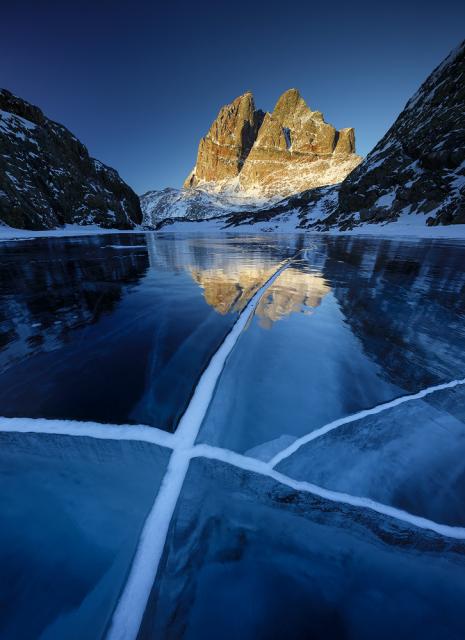 There are countless examples of when the rule of thirds doesn't apply. In this image the subjects are not placed in thirds. After reading this series, you should now understand that the photographer's thought process was as follows: 1. The relative symmetry of the background made him place the main subject (Uummannaq Mountain) near the center and slightly to the right (due to the direction of the subject). 2. To counterbalance this, he had to position the subject in the foreground (the intersection of the cracks) slightly off-center to the left.
There are countless examples of when the rule of thirds doesn't apply. In this image the subjects are not placed in thirds. After reading this series, you should now understand that the photographer's thought process was as follows: 1. The relative symmetry of the background made him place the main subject (Uummannaq Mountain) near the center and slightly to the right (due to the direction of the subject). 2. To counterbalance this, he had to position the subject in the foreground (the intersection of the cracks) slightly off-center to the left.
Canon 5D4, Canon 11-24mm F4 1/13 sec, ISO 100, F10
Tasersuaq Lake, Uummannaq, Greenland
When you subscribe to the blog, we will send you an e-mail when there are new updates on the site so you wouldn't miss them.
By accepting you will be accessing a service provided by a third-party external to https://www.insightadv.it/


































































Comments